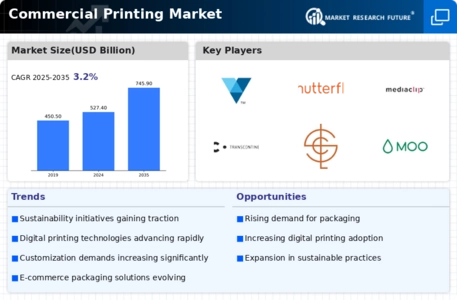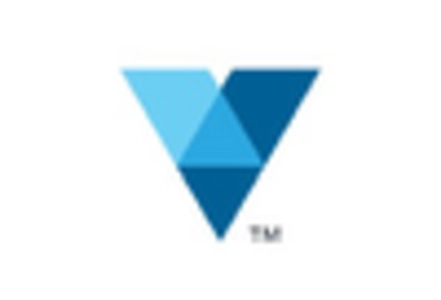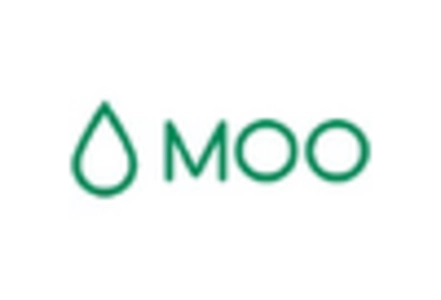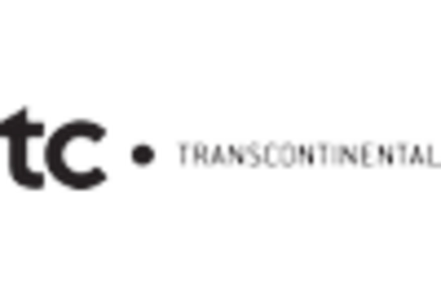-
EXECUTIVE SUMMARY
-
Market Overview
-
Key Findings
-
Market Segmentation
-
Competitive Landscape
-
Challenges and Opportunities
-
Future Outlook
-
MARKET INTRODUCTION
-
Definition
-
Scope of the study
- Research Objective
- Assumption
- Limitations
-
RESEARCH METHODOLOGY
-
Overview
-
Data Mining
-
Secondary Research
-
Primary Research
- Primary Interviews and Information Gathering Process
- Breakdown of Primary Respondents
-
Forecasting Model
-
Market Size Estimation
- Bottom-Up Approach
- Top-Down Approach
-
Data Triangulation
-
Validation
-
MARKET DYNAMICS
-
Overview
-
Drivers
-
Restraints
-
Opportunities
-
MARKET FACTOR ANALYSIS
-
Value chain Analysis
-
Porter's Five Forces Analysis
- Bargaining Power of Suppliers
- Bargaining Power of Buyers
- Threat of New Entrants
- Threat of Substitutes
- Intensity of Rivalry
-
COVID-19 Impact Analysis
- Market Impact Analysis
- Regional Impact
- Opportunity and Threat Analysis
-
COMMERCIAL PRINTING MARKET, BY PRINTING TECHNOLOGY (USD BILLION)
-
Digital Printing
-
Lithography Printing
-
Flexographic
-
Screen Printing
-
Gravure Printing
-
Others
-
COMMERCIAL PRINTING MARKET, BY APPLICATION (USD BILLION)
-
Packaging
-
Advertising
-
Publishing
-
COMMERCIAL PRINTING MARKET, BY REGIONAL (USD BILLION)
-
North America
- US
- Canada
-
Europe
- Germany
- UK
- France
- Russia
- Italy
- Spain
- Rest of Europe
-
APAC
- China
- India
- Japan
- South Korea
- Malaysia
- Thailand
- Indonesia
- Rest of APAC
-
South America
- Brazil
- Mexico
- Argentina
- Rest of South America
-
MEA
- GCC Countries
- South Africa
- Rest of MEA
-
COMPETITIVE LANDSCAPE
-
Overview
-
Competitive Analysis
-
Market share Analysis
-
Major Growth Strategy in the Commercial Printing Market
-
Competitive Benchmarking
-
Leading Players in Terms of Number of Developments in the Commercial Printing Market
-
Key developments and growth strategies
- New Product Launch/Service Deployment
- Merger & Acquisitions
- Joint Ventures
-
Major Players Financial Matrix
- Sales and Operating Income
- Major Players R&D Expenditure. 2023
-
COMPANY PROFILES
-
FedEx Office
- Financial Overview
- Products Offered
- Key Developments
- SWOT Analysis
- Key Strategies
-
Vistaprint
- Financial Overview
- Products Offered
- Key Developments
- SWOT Analysis
- Key Strategies
-
Shutterfly
- Financial Overview
- Products Offered
- Key Developments
- SWOT Analysis
- Key Strategies
-
Quad/Graphics
- Financial Overview
- Products Offered
- Key Developments
- SWOT Analysis
- Key Strategies
-
Mediaclip
- Financial Overview
- Products Offered
- Key Developments
- SWOT Analysis
- Key Strategies
-
RR Donnelley
- Financial Overview
- Products Offered
- Key Developments
- SWOT Analysis
- Key Strategies
-
TC Transcontinental
- Financial Overview
- Products Offered
- Key Developments
- SWOT Analysis
- Key Strategies
-
Cimpress Plc
- Financial Overview
- Products Offered
- Key Developments
- SWOT Analysis
- Key Strategies
-
Internal Revenue Service
- Financial Overview
- Products Offered
- Key Developments
- SWOT Analysis
- Key Strategies
-
Domtar Corporation
- Financial Overview
- Products Offered
- Key Developments
- SWOT Analysis
- Key Strategies
-
Data Communications Management
- Financial Overview
- Products Offered
- Key Developments
- SWOT Analysis
- Key Strategies
-
Deluxe Corporation
- Financial Overview
- Products Offered
- Key Developments
- SWOT Analysis
- Key Strategies
-
LSC Communications
- Financial Overview
- Products Offered
- Key Developments
- SWOT Analysis
- Key Strategies
-
Moo
- Financial Overview
- Products Offered
- Key Developments
- SWOT Analysis
- Key Strategies
-
Cimpress
- Financial Overview
- Products Offered
- Key Developments
- SWOT Analysis
- Key Strategies
-
APPENDIX
-
References
-
Related Reports
-
LIST OF TABLES
-
LIST OF ASSUMPTIONS
-
NORTH AMERICA COMMERCIAL PRINTING MARKET SIZE ESTIMATES & FORECAST, BY PRINTING TECHNOLOGY, 2019-2035 (USD BILLIONS)
-
NORTH AMERICA COMMERCIAL PRINTING MARKET SIZE ESTIMATES & FORECAST, BY APPLICATION, 2019-2035 (USD BILLIONS)
-
NORTH AMERICA COMMERCIAL PRINTING MARKET SIZE ESTIMATES & FORECAST, BY REGIONAL, 2019-2035 (USD BILLIONS)
-
US COMMERCIAL PRINTING MARKET SIZE ESTIMATES & FORECAST, BY PRINTING TECHNOLOGY, 2019-2035 (USD BILLIONS)
-
US COMMERCIAL PRINTING MARKET SIZE ESTIMATES & FORECAST, BY APPLICATION, 2019-2035 (USD BILLIONS)
-
US COMMERCIAL PRINTING MARKET SIZE ESTIMATES & FORECAST, BY REGIONAL, 2019-2035 (USD BILLIONS)
-
CANADA COMMERCIAL PRINTING MARKET SIZE ESTIMATES & FORECAST, BY PRINTING TECHNOLOGY, 2019-2035 (USD BILLIONS)
-
CANADA COMMERCIAL PRINTING MARKET SIZE ESTIMATES & FORECAST, BY APPLICATION, 2019-2035 (USD BILLIONS)
-
CANADA COMMERCIAL PRINTING MARKET SIZE ESTIMATES & FORECAST, BY REGIONAL, 2019-2035 (USD BILLIONS)
-
EUROPE COMMERCIAL PRINTING MARKET SIZE ESTIMATES & FORECAST, BY PRINTING TECHNOLOGY, 2019-2035 (USD BILLIONS)
-
EUROPE COMMERCIAL PRINTING MARKET SIZE ESTIMATES & FORECAST, BY APPLICATION, 2019-2035 (USD BILLIONS)
-
EUROPE COMMERCIAL PRINTING MARKET SIZE ESTIMATES & FORECAST, BY REGIONAL, 2019-2035 (USD BILLIONS)
-
GERMANY COMMERCIAL PRINTING MARKET SIZE ESTIMATES & FORECAST, BY PRINTING TECHNOLOGY, 2019-2035 (USD BILLIONS)
-
GERMANY COMMERCIAL PRINTING MARKET SIZE ESTIMATES & FORECAST, BY APPLICATION, 2019-2035 (USD BILLIONS)
-
GERMANY COMMERCIAL PRINTING MARKET SIZE ESTIMATES & FORECAST, BY REGIONAL, 2019-2035 (USD BILLIONS)
-
UK COMMERCIAL PRINTING MARKET SIZE ESTIMATES & FORECAST, BY PRINTING TECHNOLOGY, 2019-2035 (USD BILLIONS)
-
UK COMMERCIAL PRINTING MARKET SIZE ESTIMATES & FORECAST, BY APPLICATION, 2019-2035 (USD BILLIONS)
-
UK COMMERCIAL PRINTING MARKET SIZE ESTIMATES & FORECAST, BY REGIONAL, 2019-2035 (USD BILLIONS)
-
FRANCE COMMERCIAL PRINTING MARKET SIZE ESTIMATES & FORECAST, BY PRINTING TECHNOLOGY, 2019-2035 (USD BILLIONS)
-
FRANCE COMMERCIAL PRINTING MARKET SIZE ESTIMATES & FORECAST, BY APPLICATION, 2019-2035 (USD BILLIONS)
-
FRANCE COMMERCIAL PRINTING MARKET SIZE ESTIMATES & FORECAST, BY REGIONAL, 2019-2035 (USD BILLIONS)
-
RUSSIA COMMERCIAL PRINTING MARKET SIZE ESTIMATES & FORECAST, BY PRINTING TECHNOLOGY, 2019-2035 (USD BILLIONS)
-
RUSSIA COMMERCIAL PRINTING MARKET SIZE ESTIMATES & FORECAST, BY APPLICATION, 2019-2035 (USD BILLIONS)
-
RUSSIA COMMERCIAL PRINTING MARKET SIZE ESTIMATES & FORECAST, BY REGIONAL, 2019-2035 (USD BILLIONS)
-
ITALY COMMERCIAL PRINTING MARKET SIZE ESTIMATES & FORECAST, BY PRINTING TECHNOLOGY, 2019-2035 (USD BILLIONS)
-
ITALY COMMERCIAL PRINTING MARKET SIZE ESTIMATES & FORECAST, BY APPLICATION, 2019-2035 (USD BILLIONS)
-
ITALY COMMERCIAL PRINTING MARKET SIZE ESTIMATES & FORECAST, BY REGIONAL, 2019-2035 (USD BILLIONS)
-
SPAIN COMMERCIAL PRINTING MARKET SIZE ESTIMATES & FORECAST, BY PRINTING TECHNOLOGY, 2019-2035 (USD BILLIONS)
-
SPAIN COMMERCIAL PRINTING MARKET SIZE ESTIMATES & FORECAST, BY APPLICATION, 2019-2035 (USD BILLIONS)
-
SPAIN COMMERCIAL PRINTING MARKET SIZE ESTIMATES & FORECAST, BY REGIONAL, 2019-2035 (USD BILLIONS)
-
REST OF EUROPE COMMERCIAL PRINTING MARKET SIZE ESTIMATES & FORECAST, BY PRINTING TECHNOLOGY, 2019-2035 (USD BILLIONS)
-
REST OF EUROPE COMMERCIAL PRINTING MARKET SIZE ESTIMATES & FORECAST, BY APPLICATION, 2019-2035 (USD BILLIONS)
-
REST OF EUROPE COMMERCIAL PRINTING MARKET SIZE ESTIMATES & FORECAST, BY REGIONAL, 2019-2035 (USD BILLIONS)
-
APAC COMMERCIAL PRINTING MARKET SIZE ESTIMATES & FORECAST, BY PRINTING TECHNOLOGY, 2019-2035 (USD BILLIONS)
-
APAC COMMERCIAL PRINTING MARKET SIZE ESTIMATES & FORECAST, BY APPLICATION, 2019-2035 (USD BILLIONS)
-
APAC COMMERCIAL PRINTING MARKET SIZE ESTIMATES & FORECAST, BY REGIONAL, 2019-2035 (USD BILLIONS)
-
CHINA COMMERCIAL PRINTING MARKET SIZE ESTIMATES & FORECAST, BY PRINTING TECHNOLOGY, 2019-2035 (USD BILLIONS)
-
CHINA COMMERCIAL PRINTING MARKET SIZE ESTIMATES & FORECAST, BY APPLICATION, 2019-2035 (USD BILLIONS)
-
CHINA COMMERCIAL PRINTING MARKET SIZE ESTIMATES & FORECAST, BY REGIONAL, 2019-2035 (USD BILLIONS)
-
INDIA COMMERCIAL PRINTING MARKET SIZE ESTIMATES & FORECAST, BY PRINTING TECHNOLOGY, 2019-2035 (USD BILLIONS)
-
INDIA COMMERCIAL PRINTING MARKET SIZE ESTIMATES & FORECAST, BY APPLICATION, 2019-2035 (USD BILLIONS)
-
INDIA COMMERCIAL PRINTING MARKET SIZE ESTIMATES & FORECAST, BY REGIONAL, 2019-2035 (USD BILLIONS)
-
JAPAN COMMERCIAL PRINTING MARKET SIZE ESTIMATES & FORECAST, BY PRINTING TECHNOLOGY, 2019-2035 (USD BILLIONS)
-
JAPAN COMMERCIAL PRINTING MARKET SIZE ESTIMATES & FORECAST, BY APPLICATION, 2019-2035 (USD BILLIONS)
-
JAPAN COMMERCIAL PRINTING MARKET SIZE ESTIMATES & FORECAST, BY REGIONAL, 2019-2035 (USD BILLIONS)
-
SOUTH KOREA COMMERCIAL PRINTING MARKET SIZE ESTIMATES & FORECAST, BY PRINTING TECHNOLOGY, 2019-2035 (USD BILLIONS)
-
SOUTH KOREA COMMERCIAL PRINTING MARKET SIZE ESTIMATES & FORECAST, BY APPLICATION, 2019-2035 (USD BILLIONS)
-
SOUTH KOREA COMMERCIAL PRINTING MARKET SIZE ESTIMATES & FORECAST, BY REGIONAL, 2019-2035 (USD BILLIONS)
-
MALAYSIA COMMERCIAL PRINTING MARKET SIZE ESTIMATES & FORECAST, BY PRINTING TECHNOLOGY, 2019-2035 (USD BILLIONS)
-
MALAYSIA COMMERCIAL PRINTING MARKET SIZE ESTIMATES & FORECAST, BY APPLICATION, 2019-2035 (USD BILLIONS)
-
MALAYSIA COMMERCIAL PRINTING MARKET SIZE ESTIMATES & FORECAST, BY REGIONAL, 2019-2035 (USD BILLIONS)
-
THAILAND COMMERCIAL PRINTING MARKET SIZE ESTIMATES & FORECAST, BY PRINTING TECHNOLOGY, 2019-2035 (USD BILLIONS)
-
THAILAND COMMERCIAL PRINTING MARKET SIZE ESTIMATES & FORECAST, BY APPLICATION, 2019-2035 (USD BILLIONS)
-
THAILAND COMMERCIAL PRINTING MARKET SIZE ESTIMATES & FORECAST, BY REGIONAL, 2019-2035 (USD BILLIONS)
-
INDONESIA COMMERCIAL PRINTING MARKET SIZE ESTIMATES & FORECAST, BY PRINTING TECHNOLOGY, 2019-2035 (USD BILLIONS)
-
INDONESIA COMMERCIAL PRINTING MARKET SIZE ESTIMATES & FORECAST, BY APPLICATION, 2019-2035 (USD BILLIONS)
-
INDONESIA COMMERCIAL PRINTING MARKET SIZE ESTIMATES & FORECAST, BY REGIONAL, 2019-2035 (USD BILLIONS)
-
REST OF APAC COMMERCIAL PRINTING MARKET SIZE ESTIMATES & FORECAST, BY PRINTING TECHNOLOGY, 2019-2035 (USD BILLIONS)
-
REST OF APAC COMMERCIAL PRINTING MARKET SIZE ESTIMATES & FORECAST, BY APPLICATION, 2019-2035 (USD BILLIONS)
-
REST OF APAC COMMERCIAL PRINTING MARKET SIZE ESTIMATES & FORECAST, BY REGIONAL, 2019-2035 (USD BILLIONS)
-
SOUTH AMERICA COMMERCIAL PRINTING MARKET SIZE ESTIMATES & FORECAST, BY PRINTING TECHNOLOGY, 2019-2035 (USD BILLIONS)
-
SOUTH AMERICA COMMERCIAL PRINTING MARKET SIZE ESTIMATES & FORECAST, BY APPLICATION, 2019-2035 (USD BILLIONS)
-
SOUTH AMERICA COMMERCIAL PRINTING MARKET SIZE ESTIMATES & FORECAST, BY REGIONAL, 2019-2035 (USD BILLIONS)
-
BRAZIL COMMERCIAL PRINTING MARKET SIZE ESTIMATES & FORECAST, BY PRINTING TECHNOLOGY, 2019-2035 (USD BILLIONS)
-
BRAZIL COMMERCIAL PRINTING MARKET SIZE ESTIMATES & FORECAST, BY APPLICATION, 2019-2035 (USD BILLIONS)
-
BRAZIL COMMERCIAL PRINTING MARKET SIZE ESTIMATES & FORECAST, BY REGIONAL, 2019-2035 (USD BILLIONS)
-
MEXICO COMMERCIAL PRINTING MARKET SIZE ESTIMATES & FORECAST, BY PRINTING TECHNOLOGY, 2019-2035 (USD BILLIONS)
-
MEXICO COMMERCIAL PRINTING MARKET SIZE ESTIMATES & FORECAST, BY APPLICATION, 2019-2035 (USD BILLIONS)
-
MEXICO COMMERCIAL PRINTING MARKET SIZE ESTIMATES & FORECAST, BY REGIONAL, 2019-2035 (USD BILLIONS)
-
ARGENTINA COMMERCIAL PRINTING MARKET SIZE ESTIMATES & FORECAST, BY PRINTING TECHNOLOGY, 2019-2035 (USD BILLIONS)
-
ARGENTINA COMMERCIAL PRINTING MARKET SIZE ESTIMATES & FORECAST, BY APPLICATION, 2019-2035 (USD BILLIONS)
-
ARGENTINA COMMERCIAL PRINTING MARKET SIZE ESTIMATES & FORECAST, BY REGIONAL, 2019-2035 (USD BILLIONS)
-
REST OF SOUTH AMERICA COMMERCIAL PRINTING MARKET SIZE ESTIMATES & FORECAST, BY PRINTING TECHNOLOGY, 2019-2035 (USD BILLIONS)
-
REST OF SOUTH AMERICA COMMERCIAL PRINTING MARKET SIZE ESTIMATES & FORECAST, BY APPLICATION, 2019-2035 (USD BILLIONS)
-
REST OF SOUTH AMERICA COMMERCIAL PRINTING MARKET SIZE ESTIMATES & FORECAST, BY REGIONAL, 2019-2035 (USD BILLIONS)
-
MEA COMMERCIAL PRINTING MARKET SIZE ESTIMATES & FORECAST, BY PRINTING TECHNOLOGY, 2019-2035 (USD BILLIONS)
-
MEA COMMERCIAL PRINTING MARKET SIZE ESTIMATES & FORECAST, BY APPLICATION, 2019-2035 (USD BILLIONS)
-
MEA COMMERCIAL PRINTING MARKET SIZE ESTIMATES & FORECAST, BY REGIONAL, 2019-2035 (USD BILLIONS)
-
GCC COUNTRIES COMMERCIAL PRINTING MARKET SIZE ESTIMATES & FORECAST, BY PRINTING TECHNOLOGY, 2019-2035 (USD BILLIONS)
-
GCC COUNTRIES COMMERCIAL PRINTING MARKET SIZE ESTIMATES & FORECAST, BY APPLICATION, 2019-2035 (USD BILLIONS)
-
GCC COUNTRIES COMMERCIAL PRINTING MARKET SIZE ESTIMATES & FORECAST, BY REGIONAL, 2019-2035 (USD BILLIONS)
-
SOUTH AFRICA COMMERCIAL PRINTING MARKET SIZE ESTIMATES & FORECAST, BY PRINTING TECHNOLOGY, 2019-2035 (USD BILLIONS)
-
SOUTH AFRICA COMMERCIAL PRINTING MARKET SIZE ESTIMATES & FORECAST, BY APPLICATION, 2019-2035 (USD BILLIONS)
-
SOUTH AFRICA COMMERCIAL PRINTING MARKET SIZE ESTIMATES & FORECAST, BY REGIONAL, 2019-2035 (USD BILLIONS)
-
REST OF MEA COMMERCIAL PRINTING MARKET SIZE ESTIMATES & FORECAST, BY PRINTING TECHNOLOGY, 2019-2035 (USD BILLIONS)
-
REST OF MEA COMMERCIAL PRINTING MARKET SIZE ESTIMATES & FORECAST, BY APPLICATION, 2019-2035 (USD BILLIONS)
-
REST OF MEA COMMERCIAL PRINTING MARKET SIZE ESTIMATES & FORECAST, BY REGIONAL, 2019-2035 (USD BILLIONS)
-
PRODUCT LAUNCH/PRODUCT DEVELOPMENT/APPROVAL
-
ACQUISITION/PARTNERSHIP
-
LIST OF FIGURES
-
MARKET SYNOPSIS
-
NORTH AMERICA COMMERCIAL PRINTING MARKET ANALYSIS
-
US COMMERCIAL PRINTING MARKET ANALYSIS BY PRINTING TECHNOLOGY
-
US COMMERCIAL PRINTING MARKET ANALYSIS BY APPLICATION
-
US COMMERCIAL PRINTING MARKET ANALYSIS BY REGIONAL
-
CANADA COMMERCIAL PRINTING MARKET ANALYSIS BY PRINTING TECHNOLOGY
-
CANADA COMMERCIAL PRINTING MARKET ANALYSIS BY APPLICATION
-
CANADA COMMERCIAL PRINTING MARKET ANALYSIS BY REGIONAL
-
EUROPE COMMERCIAL PRINTING MARKET ANALYSIS
-
GERMANY COMMERCIAL PRINTING MARKET ANALYSIS BY PRINTING TECHNOLOGY
-
GERMANY COMMERCIAL PRINTING MARKET ANALYSIS BY APPLICATION
-
GERMANY COMMERCIAL PRINTING MARKET ANALYSIS BY REGIONAL
-
UK COMMERCIAL PRINTING MARKET ANALYSIS BY PRINTING TECHNOLOGY
-
UK COMMERCIAL PRINTING MARKET ANALYSIS BY APPLICATION
-
UK COMMERCIAL PRINTING MARKET ANALYSIS BY REGIONAL
-
FRANCE COMMERCIAL PRINTING MARKET ANALYSIS BY PRINTING TECHNOLOGY
-
FRANCE COMMERCIAL PRINTING MARKET ANALYSIS BY APPLICATION
-
FRANCE COMMERCIAL PRINTING MARKET ANALYSIS BY REGIONAL
-
RUSSIA COMMERCIAL PRINTING MARKET ANALYSIS BY PRINTING TECHNOLOGY
-
RUSSIA COMMERCIAL PRINTING MARKET ANALYSIS BY APPLICATION
-
RUSSIA COMMERCIAL PRINTING MARKET ANALYSIS BY REGIONAL
-
ITALY COMMERCIAL PRINTING MARKET ANALYSIS BY PRINTING TECHNOLOGY
-
ITALY COMMERCIAL PRINTING MARKET ANALYSIS BY APPLICATION
-
ITALY COMMERCIAL PRINTING MARKET ANALYSIS BY REGIONAL
-
SPAIN COMMERCIAL PRINTING MARKET ANALYSIS BY PRINTING TECHNOLOGY
-
SPAIN COMMERCIAL PRINTING MARKET ANALYSIS BY APPLICATION
-
SPAIN COMMERCIAL PRINTING MARKET ANALYSIS BY REGIONAL
-
REST OF EUROPE COMMERCIAL PRINTING MARKET ANALYSIS BY PRINTING TECHNOLOGY
-
REST OF EUROPE COMMERCIAL PRINTING MARKET ANALYSIS BY APPLICATION
-
REST OF EUROPE COMMERCIAL PRINTING MARKET ANALYSIS BY REGIONAL
-
APAC COMMERCIAL PRINTING MARKET ANALYSIS
-
CHINA COMMERCIAL PRINTING MARKET ANALYSIS BY PRINTING TECHNOLOGY
-
CHINA COMMERCIAL PRINTING MARKET ANALYSIS BY APPLICATION
-
CHINA COMMERCIAL PRINTING MARKET ANALYSIS BY REGIONAL
-
INDIA COMMERCIAL PRINTING MARKET ANALYSIS BY PRINTING TECHNOLOGY
-
INDIA COMMERCIAL PRINTING MARKET ANALYSIS BY APPLICATION
-
INDIA COMMERCIAL PRINTING MARKET ANALYSIS BY REGIONAL
-
JAPAN COMMERCIAL PRINTING MARKET ANALYSIS BY PRINTING TECHNOLOGY
-
JAPAN COMMERCIAL PRINTING MARKET ANALYSIS BY APPLICATION
-
JAPAN COMMERCIAL PRINTING MARKET ANALYSIS BY REGIONAL
-
SOUTH KOREA COMMERCIAL PRINTING MARKET ANALYSIS BY PRINTING TECHNOLOGY
-
SOUTH KOREA COMMERCIAL PRINTING MARKET ANALYSIS BY APPLICATION
-
SOUTH KOREA COMMERCIAL PRINTING MARKET ANALYSIS BY REGIONAL
-
MALAYSIA COMMERCIAL PRINTING MARKET ANALYSIS BY PRINTING TECHNOLOGY
-
MALAYSIA COMMERCIAL PRINTING MARKET ANALYSIS BY APPLICATION
-
MALAYSIA COMMERCIAL PRINTING MARKET ANALYSIS BY REGIONAL
-
THAILAND COMMERCIAL PRINTING MARKET ANALYSIS BY PRINTING TECHNOLOGY
-
THAILAND COMMERCIAL PRINTING MARKET ANALYSIS BY APPLICATION
-
THAILAND COMMERCIAL PRINTING MARKET ANALYSIS BY REGIONAL
-
INDONESIA COMMERCIAL PRINTING MARKET ANALYSIS BY PRINTING TECHNOLOGY
-
INDONESIA COMMERCIAL PRINTING MARKET ANALYSIS BY APPLICATION
-
INDONESIA COMMERCIAL PRINTING MARKET ANALYSIS BY REGIONAL
-
REST OF APAC COMMERCIAL PRINTING MARKET ANALYSIS BY PRINTING TECHNOLOGY
-
REST OF APAC COMMERCIAL PRINTING MARKET ANALYSIS BY APPLICATION
-
REST OF APAC COMMERCIAL PRINTING MARKET ANALYSIS BY REGIONAL
-
SOUTH AMERICA COMMERCIAL PRINTING MARKET ANALYSIS
-
BRAZIL COMMERCIAL PRINTING MARKET ANALYSIS BY PRINTING TECHNOLOGY
-
BRAZIL COMMERCIAL PRINTING MARKET ANALYSIS BY APPLICATION
-
BRAZIL COMMERCIAL PRINTING MARKET ANALYSIS BY REGIONAL
-
MEXICO COMMERCIAL PRINTING MARKET ANALYSIS BY PRINTING TECHNOLOGY
-
MEXICO COMMERCIAL PRINTING MARKET ANALYSIS BY APPLICATION
-
MEXICO COMMERCIAL PRINTING MARKET ANALYSIS BY REGIONAL
-
ARGENTINA COMMERCIAL PRINTING MARKET ANALYSIS BY PRINTING TECHNOLOGY
-
ARGENTINA COMMERCIAL PRINTING MARKET ANALYSIS BY APPLICATION
-
ARGENTINA COMMERCIAL PRINTING MARKET ANALYSIS BY REGIONAL
-
REST OF SOUTH AMERICA COMMERCIAL PRINTING MARKET ANALYSIS BY PRINTING TECHNOLOGY
-
REST OF SOUTH AMERICA COMMERCIAL PRINTING MARKET ANALYSIS BY APPLICATION
-
REST OF SOUTH AMERICA COMMERCIAL PRINTING MARKET ANALYSIS BY REGIONAL
-
MEA COMMERCIAL PRINTING MARKET ANALYSIS
-
GCC COUNTRIES COMMERCIAL PRINTING MARKET ANALYSIS BY PRINTING TECHNOLOGY
-
GCC COUNTRIES COMMERCIAL PRINTING MARKET ANALYSIS BY APPLICATION
-
GCC COUNTRIES COMMERCIAL PRINTING MARKET ANALYSIS BY REGIONAL
-
SOUTH AFRICA COMMERCIAL PRINTING MARKET ANALYSIS BY PRINTING TECHNOLOGY
-
SOUTH AFRICA COMMERCIAL PRINTING MARKET ANALYSIS BY APPLICATION
-
SOUTH AFRICA COMMERCIAL PRINTING MARKET ANALYSIS BY REGIONAL
-
REST OF MEA COMMERCIAL PRINTING MARKET ANALYSIS BY PRINTING TECHNOLOGY
-
REST OF MEA COMMERCIAL PRINTING MARKET ANALYSIS BY APPLICATION
-
REST OF MEA COMMERCIAL PRINTING MARKET ANALYSIS BY REGIONAL
-
KEY BUYING CRITERIA OF COMMERCIAL PRINTING MARKET
-
RESEARCH PROCESS OF MRFR
-
DRO ANALYSIS OF COMMERCIAL PRINTING MARKET
-
DRIVERS IMPACT ANALYSIS: COMMERCIAL PRINTING MARKET
-
RESTRAINTS IMPACT ANALYSIS: COMMERCIAL PRINTING MARKET
-
SUPPLY / VALUE CHAIN: COMMERCIAL PRINTING MARKET
-
COMMERCIAL PRINTING MARKET, BY PRINTING TECHNOLOGY, 2025 (% SHARE)
-
COMMERCIAL PRINTING MARKET, BY PRINTING TECHNOLOGY, 2019 TO 2035 (USD Billions)
-
COMMERCIAL PRINTING MARKET, BY APPLICATION, 2025 (% SHARE)
-
COMMERCIAL PRINTING MARKET, BY APPLICATION, 2019 TO 2035 (USD Billions)
-
COMMERCIAL PRINTING MARKET, BY REGIONAL, 2025 (% SHARE)
-
COMMERCIAL PRINTING MARKET, BY REGIONAL, 2019 TO 2035 (USD Billions)
-
BENCHMARKING OF MAJOR COMPETITORS
-
"
















Leave a Comment